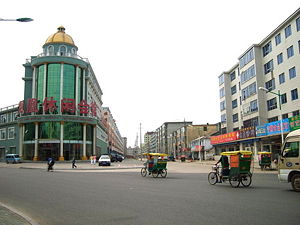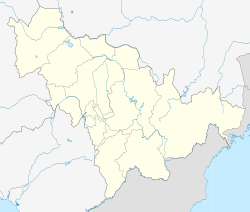Hunchun
|
Hunchun 珲春市 · 훈춘시 |
|
|---|---|
| County-level city | |

A street in Hunchun
|
|
| Location in Jilin province | |
| Coordinates: 42°52′N 130°22′E / 42.867°N 130.367°ECoordinates: 42°52′N 130°22′E / 42.867°N 130.367°E | |
| Country | China |
| Province | Jilin |
| Prefecture | Yanbian |
| Seat | Xin'an Subdistrict |
| Area | |
| • Total | 4,938 km2 (1,907 sq mi) |
| Elevation | 41 m (135 ft) |
| Population | |
| • Total | 220,000 |
| • Density | 45/km2 (120/sq mi) |
| Time zone | China Standard (UTC+8) |
| Postal code | 133300 |
| Hunchun | |||||||
| Simplified Chinese | 珲春市 | ||||||
|---|---|---|---|---|---|---|---|
| Traditional Chinese | 琿春市 | ||||||
|
|||||||
| Chinese Korean name | |||||||
| Chosŏn'gŭl | 훈춘시 | ||||||
|
|||||||
| South Korean name | |||||||
| Hangul | 훈춘 시 | ||||||
|
|||||||
| Transcriptions | |
|---|---|
| Standard Mandarin | |
| Hanyu Pinyin | Húnchūn Shì |
| Transcriptions | |
|---|---|
| Revised Romanization | Honchun-si |
| McCune–Reischauer | Honch’un-si |
| Transcriptions | |
|---|---|
| Revised Romanization | Hunchun Si |
| McCune–Reischauer | Hunch'un Si |
Hunchun is a county-level city in the Yanbian Korean Autonomous Prefecture, far eastern Jilin province, Northeast China. It borders North Korea (North Hamgyong province) and Russia (Primorsky Krai), has over 250,000 inhabitants, and covers 5,145 square kilometers. It was capital of Balhae/Bohai Kingdom between 785-793 as "Dongyang". The city's name Hunchun comes from the Manchu language meaning borderland.
The city is located near the point of junction of the borders of China, Russia, and North Korea; provided with an observation platform, it is a popular tourist attraction.
Hunchun has four subdistricts, four towns, and five townships.
Subdistricts:
Towns:
Townships:
Since the early 1990s, the Chinese government invested a lot in transforming Hunchun into a regional economic center. On 9 March 1992 the Chinese parliament approved to set up Hunchun Border Economic Cooperation Zone. The national government and Jilin provincial government have invested in succession over four billion yuan in Hunchun through the 1990s.
On 16 March 2013, a joint agreement to export textiles to North Korea was announced. The textiles would be made into up to 8,000 shirts in North Korea and exported back to China.
Hunchun Border Economic Cooperation Zone was approved to be national-level border economic cooperation zone in 1992, with a planning area of 24 km2. In 2002 and 2001, Hunchun Export Processing Zone and Huichun Sino-Russia Trade Zone was set up in it. Being located in the junction of China, Russia, and Korea, it enjoys a strategic location. The infrastructure is available. The city focuses on the development of sea food processing, electronic product manufacture, bio-pharmacy, textile industry and other industries.
...
Wikipedia

